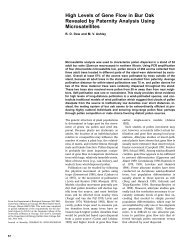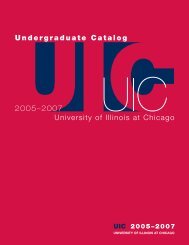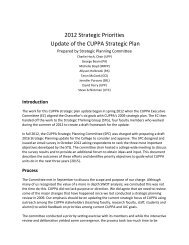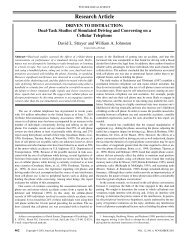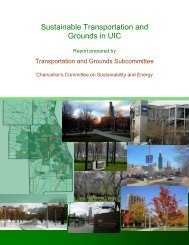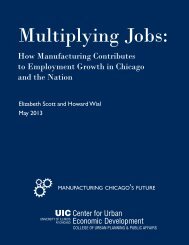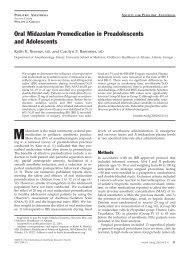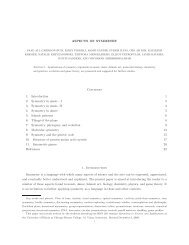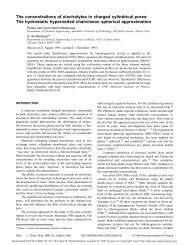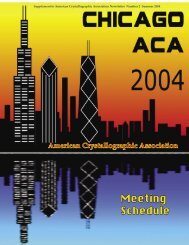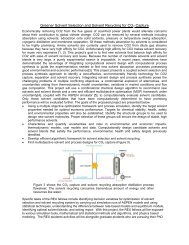Executive Summary - University of Illinois at Chicago
Executive Summary - University of Illinois at Chicago
Executive Summary - University of Illinois at Chicago
Create successful ePaper yourself
Turn your PDF publications into a flip-book with our unique Google optimized e-Paper software.
Should <strong>Chicago</strong> Have an Elected Represent<strong>at</strong>ive School Board?<br />
A Look <strong>at</strong> the Evidence<br />
Pauline Lipman (plipman@uic.edu) and Eric (Rico) Gutstein (gutstein@uic.edu)<br />
<strong>University</strong> <strong>of</strong> <strong>Illinois</strong> <strong>at</strong> <strong>Chicago</strong>, Collabor<strong>at</strong>ive for Equity and Justice in<br />
Educ<strong>at</strong>ion1040 W. Harrison St., M/C 147, <strong>Chicago</strong> IL 60607<br />
http://www.uic.edu/educ/ceje/<br />
FEBRUARY 2011<br />
EXECUTIVE SUMMARY<br />
In December 2010, the <strong>Chicago</strong> Teachers Union-Community Board<br />
proposed a shift from a mayor-appointed school board to an elected<br />
board represent<strong>at</strong>ive <strong>of</strong> and directly accountable to <strong>Chicago</strong> Public<br />
Schools’ constituencies. This report, authored independently <strong>of</strong> the<br />
Community Board, summarizes research on the effectiveness <strong>of</strong> mayorappointed<br />
school boards and the record <strong>of</strong> <strong>Chicago</strong>’s mayor-appointed<br />
board. The report was written to provide inform<strong>at</strong>ion to elected <strong>of</strong>ficials,<br />
educ<strong>at</strong>ors, parents, and members <strong>of</strong> the general public concerned about<br />
improvement <strong>of</strong> educ<strong>at</strong>ion in <strong>Chicago</strong> and the proposal to shift to an<br />
elected represent<strong>at</strong>ive school board.<br />
This report addresses the question: Should <strong>Chicago</strong> Have an<br />
Elected, Represent<strong>at</strong>ive School Board? To address this question we<br />
explored several sub-questions:<br />
• Wh<strong>at</strong> does research say about the track record <strong>of</strong> mayor-controlled<br />
school systems?<br />
• Has mayoral control improved educ<strong>at</strong>ion for <strong>Chicago</strong> public school<br />
students?<br />
• Have the appointed board’s policies increased educ<strong>at</strong>ional equity?<br />
• Are there examples where elected boards have been responsive<br />
and accountable to educ<strong>at</strong>ors and communities?
To answer these questions, we reviewed research on school<br />
governance n<strong>at</strong>ionally. To review the record <strong>of</strong> <strong>Chicago</strong>’s mayorappointed<br />
board we examined CPS and <strong>Illinois</strong> St<strong>at</strong>e Board <strong>of</strong> Educ<strong>at</strong>ion<br />
d<strong>at</strong>a, reports <strong>of</strong> research pertinent to the <strong>Chicago</strong> experience, <strong>Chicago</strong>’s<br />
performance on the N<strong>at</strong>ional Assessment <strong>of</strong> Educ<strong>at</strong>ional Progress (NAEP),<br />
and qualit<strong>at</strong>ive studies <strong>of</strong> the effects <strong>of</strong> CPS policies on teaching,<br />
students, and communities. We also g<strong>at</strong>hered inform<strong>at</strong>ion on elected<br />
school boards in four major cities drawing on media reports, published<br />
research, school district websites, and convers<strong>at</strong>ions with local actors.<br />
Key findings are:<br />
1. There is no conclusive evidence th<strong>at</strong> mayoral control and<br />
mayor-appointed boards are more effective <strong>at</strong> governing<br />
schools or raising student achievement.<br />
2. The Board’s policies <strong>of</strong> top-down accountability based on<br />
standardized tests, and its simultaneous expansion <strong>of</strong><br />
selective-enrollment schools, expanded a two-tier educ<strong>at</strong>ion<br />
system in <strong>Chicago</strong>. Based on their scores on a single test,<br />
thousands <strong>of</strong> primarily African American and L<strong>at</strong>ino students were<br />
subjected to prob<strong>at</strong>ion, retention, scripted instruction, test drills,<br />
and basic-skills educ<strong>at</strong>ion. This was not supported by educ<strong>at</strong>ion<br />
research, did not result in real improvement, and reinforced a<br />
lower tier <strong>of</strong> educ<strong>at</strong>ional opportunities for these students. At the<br />
same time, the Board also expanded a top tier <strong>of</strong> world-class,<br />
selective-enrollment schools th<strong>at</strong> serve just 10 percent <strong>of</strong> high<br />
school students and are roughly three times more white and more<br />
affluent than CPS high schools overall.<br />
3. Under the mayor-appointed Board, CPS has made little<br />
progress in academic achievement and other measures <strong>of</strong><br />
educ<strong>at</strong>ional improvement, and on nearly every measure there<br />
are persistent, and in some cases, widening gaps between<br />
white students and African American and L<strong>at</strong>ino students.<br />
<strong>Chicago</strong>’s scores on the NAEP have increased very modestly in<br />
ways th<strong>at</strong> cannot be distinguished from increases in other urban<br />
districts, and <strong>Chicago</strong> continues to significantly lag behind other<br />
large cities. There are persistent and significant racial disparities <strong>at</strong><br />
the At-Or-Above-Pr<strong>of</strong>icient and Advanced levels in m<strong>at</strong>h and<br />
reading on the NAEP, and scores for African American students <strong>at</strong><br />
these levels are abysmal. Gradu<strong>at</strong>ion and dropout r<strong>at</strong>es have
improved slightly but gradu<strong>at</strong>ion r<strong>at</strong>es are still very low and<br />
dropout r<strong>at</strong>es still very high, and the gap between the r<strong>at</strong>es for<br />
whites and for African Americans and L<strong>at</strong>inos has widened.<br />
4. The Board’s policy <strong>of</strong> closing neighborhood schools and<br />
opening charter schools (Renaissance 2010) has generally not<br />
improved educ<strong>at</strong>ion for the students affected. In some cases,<br />
it has made things worse. Most displaced elementary school<br />
students transferred from one low-performing school to another<br />
with virtually no effect on student achievement. Eight <strong>of</strong> ten<br />
students displaced by school closings transferred to schools th<strong>at</strong><br />
ranked in the bottom half <strong>of</strong> the system on standardized tests. In<br />
the affected communities, the policy has increased student<br />
mobility and travel distances, led to spikes in violence, and<br />
increased neighborhood instability. School closings are also<br />
associ<strong>at</strong>ed with p<strong>at</strong>terns <strong>of</strong> gentrific<strong>at</strong>ion, raising troubling<br />
questions about the rel<strong>at</strong>ionship <strong>of</strong> Board policies and real est<strong>at</strong>e<br />
interests and about the prioritiz<strong>at</strong>ion <strong>of</strong> affluent students who<br />
make up a small percentage <strong>of</strong> CPS families.<br />
5. Although d<strong>at</strong>a on charter schools, n<strong>at</strong>ionally and locally, are<br />
mixed, there is no evidence th<strong>at</strong>, overall, CPS’ charter schools<br />
are significantly better than its traditional public schools. The<br />
largest study conducted to d<strong>at</strong>e in the U.S. found th<strong>at</strong> students in<br />
charter schools are not doing as well as students in regular public<br />
schools: 17% <strong>of</strong> charter schools perform significantly better, 37%<br />
significantly worse, and 46% show no significant difference.<br />
<strong>Chicago</strong> charter school outcomes are mixed, overall showing<br />
roughly comparable performance to neighborhood schools. On<br />
average, <strong>Chicago</strong> charter high schools served fewer English<br />
language learners and low-income and special educ<strong>at</strong>ion students,<br />
and on average, <strong>Chicago</strong> charter schools replaced more than half <strong>of</strong><br />
their staff between 2008 and 2010.<br />
6. <strong>Chicago</strong>’s mayor-appointed board is comprised <strong>of</strong> elite<br />
decision makers who are neither represent<strong>at</strong>ive <strong>of</strong> the student<br />
popul<strong>at</strong>ion <strong>of</strong> CPS nor directly accountable to the public.<br />
Board structures and processes severely limit public input in<br />
decisions. The Board is composed primarily <strong>of</strong> corpor<strong>at</strong>e<br />
executives, while the district is 92 percent students <strong>of</strong> color and 86<br />
percent low-income students whose communities have no role in<br />
school district decisions. This is problem<strong>at</strong>ic because perspectives<br />
and knowledge <strong>of</strong> parents, educ<strong>at</strong>ors, and students are essential to
good educ<strong>at</strong>ional decision-making. It is evident th<strong>at</strong> community<br />
members feel th<strong>at</strong> the Board is unresponsive to their input and<br />
concerns. Parents have felt it necessary to take extreme measures to<br />
be heard, including candlelight vigils, marches, campouts in front <strong>of</strong><br />
Board headquarters, a hunger strike, and a recent 43-day occup<strong>at</strong>ion<br />
<strong>of</strong> a school field house to get a long-needed school library. Case<br />
studies in this report illustr<strong>at</strong>e th<strong>at</strong> elected school boards can cre<strong>at</strong>e<br />
conditions for democr<strong>at</strong>ic public particip<strong>at</strong>ion.<br />
The evidence we collected for this report does not support the<br />
“<strong>Chicago</strong> miracle.” There is compelling evidence th<strong>at</strong>, for over 15 years,<br />
the Board’s policies have failed to improve the educ<strong>at</strong>ion <strong>of</strong> the majority<br />
<strong>of</strong> <strong>Chicago</strong> public school students, especially African American and<br />
L<strong>at</strong>ino and low-income students. Some students’ entire K-12 educ<strong>at</strong>ion<br />
has been domin<strong>at</strong>ed by high-stakes testing, the fear <strong>of</strong> retention, a basiclevel<br />
educ<strong>at</strong>ion, and school closings and their resulting instability. There<br />
is an urgent need to shift course. Although responsive and directly<br />
accountable governance structures are not sufficient by themselves to<br />
improve schools, they are an important condition.<br />
Recommend<strong>at</strong>ions:<br />
• <strong>Chicago</strong> should transition to an elected represent<strong>at</strong>ive school<br />
board (ERSB).<br />
• The ERSB’s oper<strong>at</strong>ions should be transparent and publicly<br />
accountable.<br />
• The ERSB should establish structures and practices th<strong>at</strong><br />
strengthen democr<strong>at</strong>ic public particip<strong>at</strong>ion in district<br />
initi<strong>at</strong>ives and decisions.<br />
• The ERSB should draw on sound educ<strong>at</strong>ional research and<br />
educ<strong>at</strong>or, student, and community knowledge to develop and<br />
evalu<strong>at</strong>e policy.<br />
• Achieving equity in educ<strong>at</strong>ional opportunities and outcomes<br />
should be integral to all ERSB decisions



